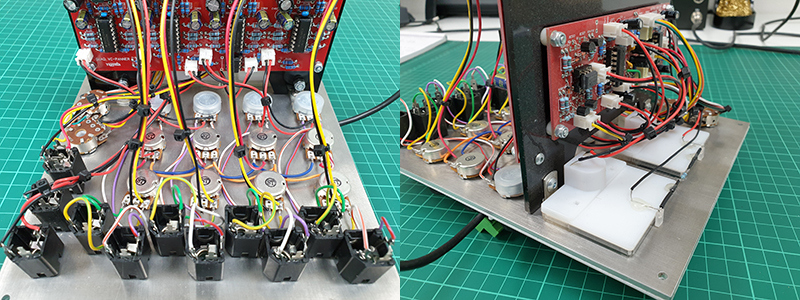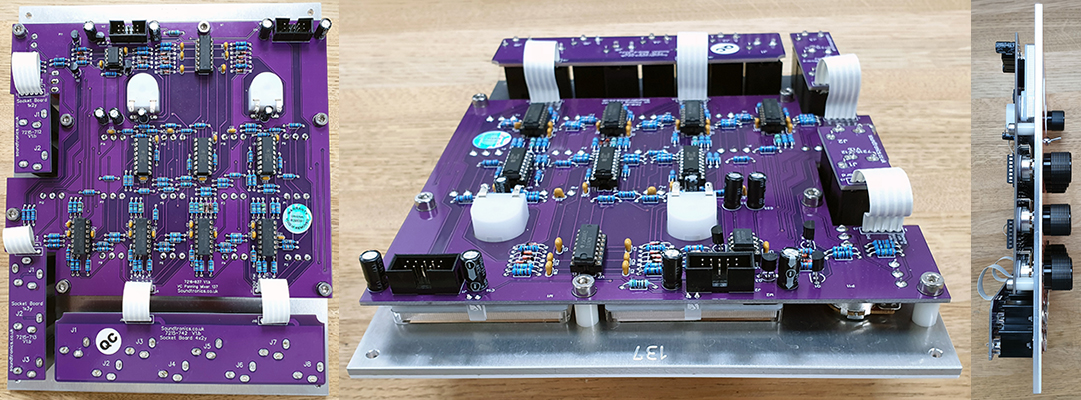Can I build the M²Synth?
Unlike the MFOS and YuSynth synths, the M²Synth was not designed with the diy'er in mind but as a commercial product. This has benefits and disadvantages to the builder:
Benefits:
- Well proven design already in commercial production
- Put the right components in the right place, decent soldering and it will work first time
- Designed for fast assembly - no panel wiring
- Purpose made enclosure including an integral power supply available
- Kits are based on mostly through hole components although there is always the chance of the odd SMT chip being used especially with CPU / DSP based modules.
Disadvantages:
- Being of a low-profile design, PCB component density is higher than other DIY kits
- PCB pad sizes and trace widths are smaller so easier to damage the PCB if your construction skills are lacking by having to re-work the board due to insertion errors
- All PCBs have a ground plane top and bottom so a very good high-powered soldering iron is essential otherwise you will not get a decent joint or may damage the PCB / component from excess heat from long tip touch times
- We are not going to teach you about how it works unlike the excellent MFOS module descriptions. You will get a schematic with the PCB and with the kits, further build information can be found in this section of the website. This level of documentation is more than sufficient for the seasoned hackers amongst you
If you are new to electronics / soldering then the M²Synth is not the place to start. If you have the correct tools and test gear, know your way around assembling PCBs and how to solder then you have come to the right place.
Read the general build guide for assembling a M²Synth module here.
How does building a M²Synth module in MOTM format compare to MFOS / YuSynth Modules?
Naturally there are many similarities as the outcome of a 5U module build remains identical. The fundamental difference is the focus on eliminating panel wiring which is the cause of many issues with DIY modules. These photos are of similar panning mixers, starting with the YuSynth.

With the M²Synth, switches, pots and sockets are all PCB mounted leaving just a header cable to link the PCBs together.

Gone is the need for deep cabinets thanks to the low profile design of the M²Synth and gone is that panel wiring. Even the VU meters and their illumination is PCB mounted. PCBs are securely mounted to to the aluminium back panel using M4 screws for a robust mount making it resistant to damage from shock in transit. Especially nice if taking your synth to gigs or modular meets. The MU version has an acrylic spacer to which the PCB is fixed using the same M4 screws as the MOTM version.
Are there any differences between the kit versions and the ready assembled versions?
Ready assembled modules from Soundtronics use a purple coloured PCB, kits will use a blue PCB. This is to differentiate between modules made by the diy'er and by Soundtronics. This could be an important consideration to resale value of modules and systems on the second-hand market.
The fundamental designs between the assembled and kit versions will be aligned and developed together. The assembled version will migrate to SMT overtime whereas the kit version will remain as through hole unless scarcity of semiconductors require just selected chips to be SMT.
I already have a MFOS / YuSynth system, will the M²Synth work with these?
MFOS yes, YuSynth also yes but be aware that the M²Synth runs on +/-12V just like the MFOS modules but many YuSynth builders operate their modules on +/-15V. This means you cannot run a M²Synth module on +/-15V direct without the optional in-line voltage converter to drop it down to +/-12V. Other than that, the actual signals used are all compatible with each other so no worries over patching modules between any of the three 'brands'.
The panels we supply for MFOS, YuSynth and now the M²Synth are all based on what is commonly referred to as MOTM. This means all panels are 5U high and come in multiple widths of 1U. This should not be confused with 5U panels that come in multiples of 1MU aka 'Moog units'. Our MU version follows the MU widths.
What tech support will I get?
You should not need any support if you have heeded the above warnings. If it should be necessary then post on our support forum on the modwiggler site here.
M²Synth Module Kits
The MOTM and MU formats are listed within their own sections.
There are no products in this section
